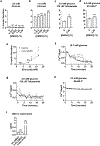Dimethyl sulfoxide acutely enhances regulated insulin secretion in the MIN6-K8 mouse insulinoma cell line
- PMID: 33743067
- PMCID: PMC8277720
- DOI: 10.1007/s00418-021-01984-z
Dimethyl sulfoxide acutely enhances regulated insulin secretion in the MIN6-K8 mouse insulinoma cell line
Erratum in
-
Correction to: Dimethyl sulfoxide acutely enhances regulated insulin secretion in the MIN6-K8 mouse insulinoma cell line.Histochem Cell Biol. 2021 Jul;156(1):75-77. doi: 10.1007/s00418-021-01988-9. Histochem Cell Biol. 2021. PMID: 33969429 Free PMC article. No abstract available.
Abstract
Diabetes mellitus is a metabolic disorder projected to afflict 700 million people globally by 2045. Fundamental to the progression of diabetes is an insufficient supply of insulin to meet metabolic demand. The MIN6-K8 cell line is a mouse insulinoma model of pancreatic β-cells frequently used to study the mechanisms of insulin secretion. Here, we evaluated the effects of short-term exposure to dimethyl sulfoxide (DMSO), a polar aprotic solvent commonly used in drug screening, on physiological characteristics of MIN6-K8 cells. Short-term exposure of MIN6-K8 cells to DMSO enhanced glucose-induced and tolbutamide-stimulated insulin secretion without significant effects on basal secretion or potassium responsiveness. Calcium influx was enhanced during glucose and tolbutamide treatments, suggesting that DMSO's mechanism of action is upstream of calcium-dependent insulin granule exocytosis. Based on these studies, investigators should use caution when conducting experiments with DMSO in the MIN6-K8 cell line and should report all DMSO concentrations when used as a solvent.
Keywords: Diabetes; Dimethyl sulfoxide; Drug discovery; Drug screening; Glucose; Insulin secretion.
© 2021. The Author(s), under exclusive licence to Springer-Verlag GmbH Germany, part of Springer Nature.
Conflict of interest statement
Declarations
Figures

Similar articles
-
Selenomethionine modulates insulin secretion in the MIN6-K8 mouse insulinoma cell line.FEBS Lett. 2021 Dec;595(24):3042-3055. doi: 10.1002/1873-3468.14232. Epub 2021 Nov 30. FEBS Lett. 2021. PMID: 34780071 Free PMC article.
-
Correction to: Dimethyl sulfoxide acutely enhances regulated insulin secretion in the MIN6-K8 mouse insulinoma cell line.Histochem Cell Biol. 2021 Jul;156(1):75-77. doi: 10.1007/s00418-021-01988-9. Histochem Cell Biol. 2021. PMID: 33969429 Free PMC article. No abstract available.
-
MiD51 Is Important for Maintaining Mitochondrial Health in Pancreatic Islet and MIN6 Cells.Front Endocrinol (Lausanne). 2020 Apr 28;11:232. doi: 10.3389/fendo.2020.00232. eCollection 2020. Front Endocrinol (Lausanne). 2020. PMID: 32411091 Free PMC article.
-
Pancreatic β cell models for screening insulin secretagogues and cytotoxicity.J Appl Toxicol. 2025 Jan;45(1):89-106. doi: 10.1002/jat.4658. Epub 2024 Jun 22. J Appl Toxicol. 2025. PMID: 39662958 Review.
-
Dimethyl sulfoxide (DMSO): a review.Cornell Vet. 1986 Jan;76(1):61-90. Cornell Vet. 1986. PMID: 3510103 Review.
Cited by
-
Inhibition of α-Amylase and α-Glucosidase Using Baccaurea ramiflora.Scientifica (Cairo). 2025 Jun 16;2025:8768659. doi: 10.1155/sci5/8768659. eCollection 2025. Scientifica (Cairo). 2025. PMID: 40551810 Free PMC article.
-
New Treatment for Type 2 Diabetes Mellitus Using a Novel Bipyrazole Compound.Cells. 2023 Jan 9;12(2):267. doi: 10.3390/cells12020267. Cells. 2023. PMID: 36672202 Free PMC article.
-
Experimental Approaches to Diabetes Mellitus.Eurasian J Med. 2022 Dec;54(Suppl1):145-153. doi: 10.5152/eurasianjmed.2022.22304. Eurasian J Med. 2022. PMID: 36655459 Free PMC article.
References
-
- Brayton CF (1986) Dimethyl sulfoxide (DMSO): a review. Cornell Vet 76 (1):61–90 - PubMed
-
- Briscoe CP, Peat AJ, McKeown SC, Corbett DF, Goetz AS, Littleton TR, McCoy DC, Kenakin TP, Andrews JL, Ammala C, Fornwald JA, Ignar DM, Jenkinson S (2006) Pharmacological regulation of insulin secretion in MIN6 cells through the fatty acid receptor GPR40: identification of agonist and antagonist small molecules. Br J Pharmacol 148 (5):619–628. doi:10.1038/sj.bjp.0706770 - DOI - PMC - PubMed
-
- Carmean CM, Yokoi N, Takahashi H, Oduori OS, Kang C, Kanagawa A, Kirkley AG, Han G, Landeche M, Hidaka S, Katoh M, Sargis RM, Seino S (2018) Arsenic modifies serotonin metabolism through glucuronidation in pancreatic β-cells. Am J Physiol Endocrinol Metab. doi:10.1152/ajpendo.00302.2018 - DOI - PMC - PubMed
-
- Ferdaoussi M, Dai X, Jensen MV, Wang R, Peterson BS, Huang C, Ilkayeva O, Smith N, Miller N, Hajmrle C, Spigelman AF, Wright RC, Plummer G, Suzuki K, Mackay JP, van de Bunt M, Gloyn AL, Ryan TE, Norquay LD, Brosnan MJ, Trimmer JK, Rolph TP, Kibbey RG, Manning Fox JE, Colmers WF, Shirihai OS, Neufer PD, Yeh ET, Newgard CB, MacDonald PE (2015) Isocitrate-to-SENP1 signaling amplifies insulin secretion and rescues dysfunctional β cells. J Clin Invest 125 (10):3847–3860. doi:10.1172/JCI82498 - DOI - PMC - PubMed
MeSH terms
Substances
Grants and funding
LinkOut - more resources
Full Text Sources
Other Literature Sources
Medical
Research Materials

